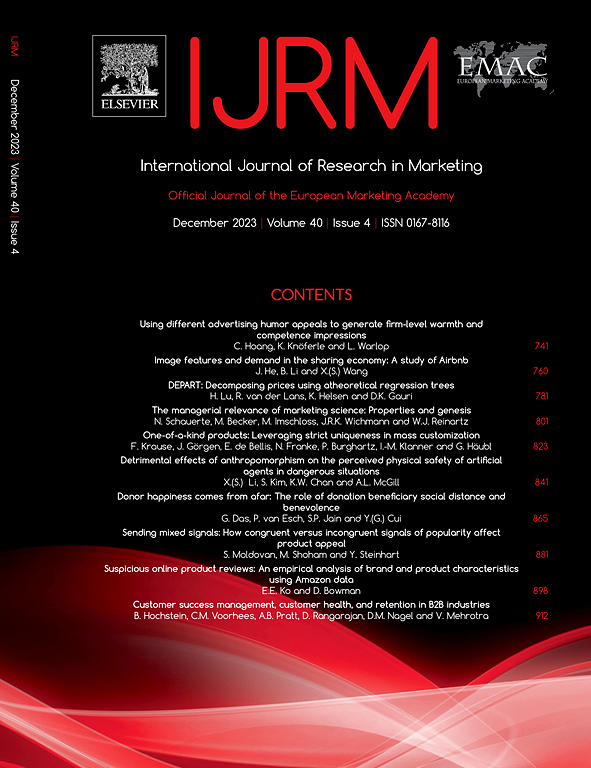为商店传单空间分配开发决策支持系统:利用自有和跨品类销售效应
IF 7.5
2区 管理学
Q1 BUSINESS
International Journal of Research in Marketing
Pub Date : 2025-03-01
DOI:10.1016/j.ijresmar.2024.07.002
引用次数: 0
摘要
印刷商店传单的特点是零售商的分类仍然是一个关键的零售营销沟通工具,使他们的空间分配在不同的产品类别是一个重要的决定。关于商店传单的学术研究大多采用描述性的方法,专注于大量(通常是竞争的)类别被推广的杂货店环境,忽略了跨类别传单空间的影响。我们通过解决非杂货零售商如何在展示传单中最好地分配空间来突出几个类别的分类,以最大限度地提高总商店收入。为此,我们开发了一个动态的决策支持系统(DSS)来处理本品类和跨品类传单空间对销售的影响。我们的DSS具有两个组成部分:(1)销售响应模型和(2)商店传单空间分配工具,该工具使用定制的大邻居搜索启发式方法在不到一分钟的时间内解决商店传单空间分配问题。动态捕获使用时间变化的基线估计,通过限制同一季节内后续传单的重叠水平,产生最佳传单,以服务于不同的季节。在一个家具和家居用品零售商的实证应用中,与该零售商的实际传单相比,我们的优化产生了13.0%的总体平均预期销售改善。通过利用跨品类效应,商店传单变得更具主题性,因为它们集中在一个或两个部门。本文章由计算机程序翻译,如有差异,请以英文原文为准。
Decision support system development for store flyer space allocation: Leveraging own- and cross-category sales effects
Print store flyers that feature retailer assortments remain a key retail marketing communication tool, making their space allocation among various product categories a vital decision. Academic research on store flyers has mostly taken a descriptive approach, focused on grocery settings where a large number of (often competing) categories are promoted, neglecting cross-category flyer space effects. We advance the literature by addressing how a non-grocery retailer can best allocate space in a showcase flyer intended to highlight the assortment of a few categories, with the aim of maximizing total store revenue. For this purpose, we have developed a dynamic Decision Support System (DSS) handling own- and cross-category flyer space effects on sales. Our DSS features two components: (1) a sales response model and (2) a store flyer space allocation tool that enlists a custom-built Large Neighborhood Search heuristic to solve the store flyer space allocation problem in less than a minute. Dynamics are captured using time-varying baseline estimates that yield optimal flyers to serve different seasons by limiting the level of overlap in subsequent flyers within the same season. In an empirical application for a furniture and home goods retailer, our optimization generates an overall average expected sales improvement of 13.0% versus this retailer’s actual flyers. By exploiting cross-category effects, store flyers become more thematic as they concentrate on one or two departments.
求助全文
通过发布文献求助,成功后即可免费获取论文全文。
去求助
来源期刊
CiteScore
11.80
自引率
4.30%
发文量
77
审稿时长
66 days
期刊介绍:
The International Journal of Research in Marketing is an international, double-blind peer-reviewed journal for marketing academics and practitioners. Building on a great tradition of global marketing scholarship, IJRM aims to contribute substantially to the field of marketing research by providing a high-quality medium for the dissemination of new marketing knowledge and methods. Among IJRM targeted audience are marketing scholars, practitioners (e.g., marketing research and consulting professionals) and other interested groups and individuals.

 求助内容:
求助内容: 应助结果提醒方式:
应助结果提醒方式:


